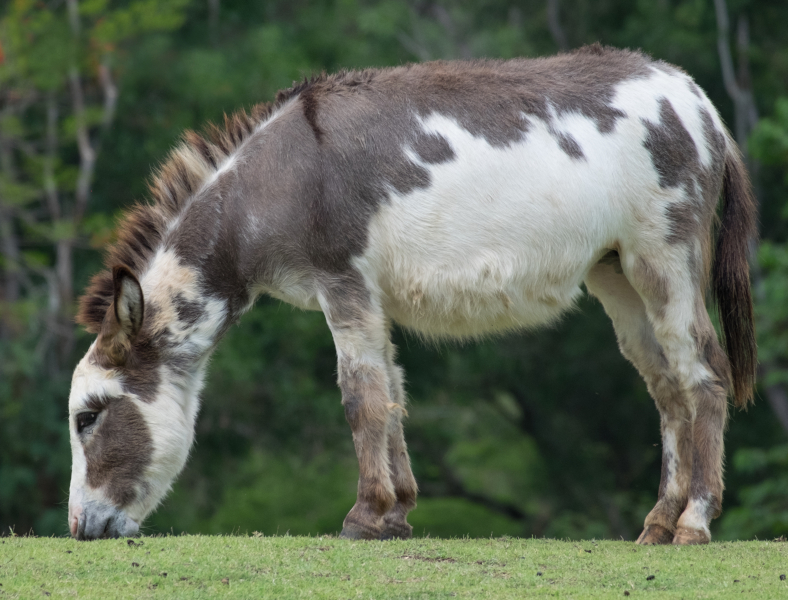Quick Summary

Click here for Price and Turnaround Time
Phenotype: White spotting patterns occur in many donkey breeds; as in horses, the amount of white can range from a few white hairs to an animal that is almost completely white.
Mode of Inheritance: Autosomal dominant
Alleles: N = Normal, W = Dominant White, WS = White Spotted
Breeds appropriate for testing: Many breeds including American Miniature and Mammoth Jack
Explanation of Results:
- Donkeys with N/N genotype are not expected to have white coats or white spotting patterns (but there may be other unidentified variants not detected by this test that cause some white patterning). Donkeys with this N/N genotype cannot transmit either of these white variants to their offspring.
- Donkeys with N/W genotype are expected to be white. They will transmit this dominant white variant to 50% of their offspring.
- Donkeys with W/Ws genotype are expected to be white. It is unknown if donkeys with this genotype are viable.
- Donkeys with N/Ws genotype are expected to be white spotted. They will transmit this white spotted variant to 50% of their offspring.
- Donkeys with W/W genotype are are expected to terminate development in utero (embryonic lethal) or be non-viable.
- The Ws/Ws genotype produces an all white donkey that is expected to be non-viable.
Donkey Coat and Hair Length Panel
$75 per animal

White spotting patterns occur in many donkey breeds and are similar to those of horses in that the amount of white can range from a few white hairs to an animal that is almost completely white. Two separate variants in the KIT gene have been identified that cause white spotting in donkeys, and they have been named dominant white (W) and white spotted (Ws). Both are inherited in an autosomal dominant fashion, meaning that only one copy of either variant is required to produce white pattern phenotypes. The genetic basis for the variability in the amount of white patterning from one donkey to another is not known.
The Ws allele has been identified in all but one white-spotted donkey studied to date. The variant (c.1978+2T>A) is located in an intron in the KIT gene. The KIT gene encodes for a tyrosine kinase receptor, which plays a role in promoting melanocyte proliferation and differentiation when activated. In the current published literature, all but one of the donkeys in which this allele has been detected have been heterozygotes (N/Ws). Homozygosity for the Ws allele is thought to be incompatible with life, and the VGL's research identified one Ws/Ws foal who died by 2 weeks of age, which suggests that this may indeed be the case. The lethal nature of this homozygosity is believed to be caused by the KIT gene's pleiotropic effects: in addition to pigment cell development, the KIT protein is also involved in the development of other cell types. For example, signaling through the KIT protein also affects specific blood cells, known as mast cells, as well as some cells of the gastrointestinal tract. Deficient KIT signaling, such as that predicted to occur in Ws/Ws homozygotes, may impair the development of these critical cell types.
The W allele has only been identified in a single individual born with an all-white phenotype (unpigmented pink skin, brown eyes, and all-white coat). The variant identified in this individual was a missense mutation in the KIT gene (c.662A>C, p.Tyr221Ser), and the individual was heterozygous for the variant (N/W). It is unlikely that a W/W donkey would be born and viable for the same reasons that Ws/Ws homozygosity is thought to lead to inviability.
Lethality of W and Ws mutations remains to be further confirmed. Additionally, there have been no reported donkeys who have one copy the W allele and one copy of the Ws allele (compound heterozygote), so viability in such cases also remains to be confirmed.
Genetic testing is recommended for all donkey breeds known to have a white spotting phenotype. Breeders can benefit from this test to determine which mutation is present in a white patterned donkey and also to select mating pairs to avoid breeding two white patterned donkeys together, as such matings may result in inviable foals.
